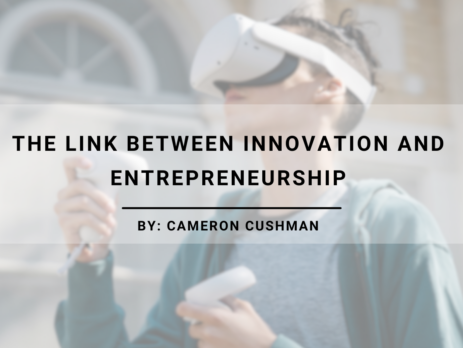Entrepreneurship and innovation share a symbiotic relationship, each fueling and catalyzing the other. At its core, entrepreneurship is about identifying opportunities and taking calculated risks to create value. Innovation, on the other hand, involves the creation and application of new ideas, technologies, or processes that bring about meaningful change. In this article we will explore how innovation has launched industries, disrupted traditional business models, and showcased the transformative power of entrepreneurial vision and inventive thinking in today’s rapidly evolving market landscapes.
Why Is Innovation Important?
Innovation is the buzz word of every business book and economic development strategy. Large, established companies love to talk about how they innovate and drive productivity, but their progress is often measured and can easily be stifled by bureaucracy, groupthink or risk-averse corporate culture. Innovation has perhaps been most effective when it comes from something entirely new, nurtured through a new company and funded through capital that is closely tied to progress and meeting specific milestones. Clearly, innovation can exist without entrepreneurship, but the secret to America’s success, and the core of the American Dream, is our ability to innovate through the creation of new companies to test, support and launch novel products and services into the marketplace.
Simply put, innovation is creating something new that didn’t exist before. It can come in many forms and can take shape as something truly novel that is completely new to an incremental change that slightly improves a known product or process.
Entrepreneurship, “the activity of setting up a business, taking on financial risks in the hope of making a profit,” has been the core of the American Dream for more than a century. On its face, these two concepts are not necessarily related, but yet they are inextricably linked. We have seen the shift of true innovation coming from startup companies rather than government entities and established businesses, large or small, over the last few decades. The act of starting a company, entrepreneurship, has become the become the most effective path for bringing disruptive innovation to market.
History of Innovation in the US
Innovation in the US has come from many places. We see instances of our founding fathers, George Washington and Thomas Jefferson, introducing innovation into their agricultural enterprises and Benjamin Franklin is a noted inventor of everything from bifocal glasses to the lightning rod. American innovation largely fueled the industrial revolution in the late 1800s and set the US on the road to becoming a global industrial and innovation powerhouse into the next century and beyond.
In the beginning of the 20th century, innovation was led by large corporations. The early part of the 1900’s was defined by companies like Ford Motor Company, General Electric (GE), and AT&T that launched entire industries (automotive, electricity and electrical systems, and telecommunications, respectively). The innovations pioneered by these and other companies paved the way for technology companies in the latter part of the century like Bell Labs, Fairchild Semiconductor and Texas Instruments. Government even led the way, especially through NASA during the Space Race of the 1960s and the creation of the early infrastructure of the internet.
Today the US continues to have many innovative companies in existence like Apple, Google, Pfizer and Tesla, yet a large portion of the innovation now occurs in startup companies. Often, these startup companies are acquired for huge sums by established companies, mostly so they can own the new technology that has been developed by the startup companies. Instagram, YouTube, and virtually every pharma acquisition over the last few decades was done in a similar way. Why is that and what caused that shift?
The Shift from Large Corporations to Startups
In November, John Dearie, the Founder and President of the Center for American Entrepreneurship shared the answer to this question in his remarks at the 6th Annual State of Entrepreneurship event in Fort Worth on November 17, 2023:
“New businesses – startups – are disproportionately responsible for innovation in the economy. Existing firms also innovate, but not in the way, or to the same extent, as new businesses. Startups are responsible for most transformative or disruptive innovation in the economy. And that makes sense. People launch a new business either because they want to work for themselves, or because they have something new – a new product, a new service, or some innovative twist on an old idea. The economic significance of that reality is that we know from the great work of American economist Robert Solow, who won the Nobel Prize in 1987 for this insight, that economic growth is driven principally by gains in productivity – doing more with less – driven by innovation.”
John Haltiwanger, a noted economist on this subject from the University of Maryland, has studied this subject extensively, most notable in this paper on the importance of new high-growth firms to innovation, productivity growth, and job creation. As Haltiwanger states:
In these models…, firms in the same industry differ in their productivity and the reallocation dynamics reflect moving resources away from less productive to more productive businesses. Such productivity differences can be endogenous given the role of innovation and R&D activities. Entrants and young businesses play a critical role in these dynamics. They put competitive pressure on incumbents and in some models they are critical for innovation (see, e.g., Acemoglu et. al. (2013).
In plain language, this means that new firms – startups – are more productive than established companies, which makes them more effective at innovating.
Bob Litan and Carl Schramm also made this point in their 2012 book “Better Capitalism: Renewing the Entrepreneurial Strength of the American Economy”
Entrepreneurs throughout modern economic history, in this country and others, have been disproportionately responsible for truly radical innovations — the airplane, the railroad, the automobile, electric service, the telegraph and telephone, the computer, air conditioning, and so on — that not only fundamentally transformed consumers’ lives, but also became platforms for many other industries that, in combination, have fundamentally changed entire economies…Large companies, with their large fixed costs of plant, equipment, and to some extent personnel, have perfected the economic arts of economies of scale production and incremental innovation. But…most large companies are less eager to pursue radical innovations — those that disrupt current business models in which the firms are heavily invested.
Everyone wants more innovation. Our society wants the cures of tomorrow and the technology that will drive us forward into the future. We want new tools to make us more efficient and make our world a better place. The 21st century has seen the US lose some of its advantage on the innovation front as other countries (like China) and economies (like the EU) spur innovation through both top-down and bottom-up approaches. Federal, state and local governments in the US need to create systems that support and incentivize startup companies to birth the new and lead the development of technologies to ensure we remain the innovation capital of the world.



